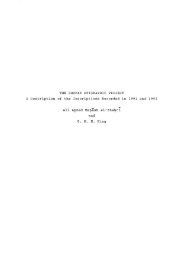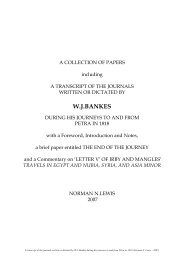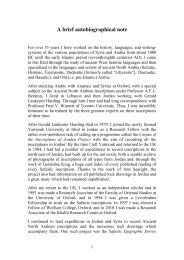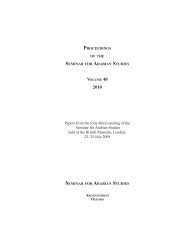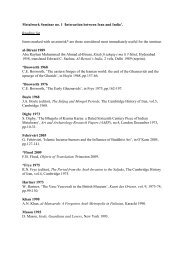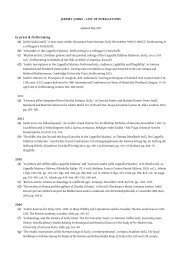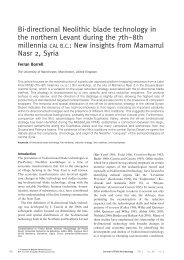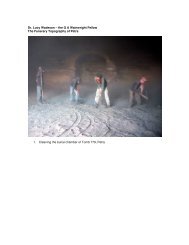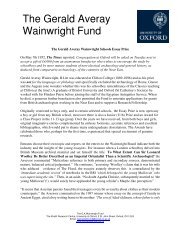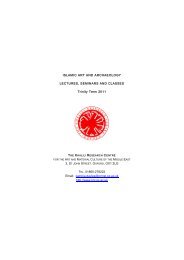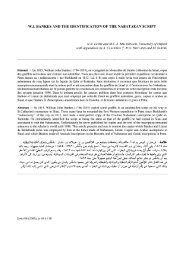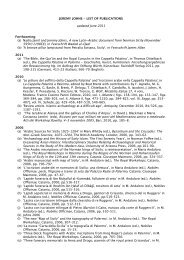Reflections on the linguistic map of pre-Islamic Arabia - Khalili ...
Reflections on the linguistic map of pre-Islamic Arabia - Khalili ...
Reflections on the linguistic map of pre-Islamic Arabia - Khalili ...
Create successful ePaper yourself
Turn your PDF publications into a flip-book with our unique Google optimized e-Paper software.
155. There is, <strong>of</strong> course, no reas<strong>on</strong> why Old Arabic,<br />
which before <strong>the</strong> sixth century AD was a purely<br />
spoken language, should not have been written<br />
in <strong>the</strong> Safaitic script from time to time, and <strong>the</strong>re<br />
are indeed some examples <strong>of</strong> this, see below<br />
and Macd<strong>on</strong>ald, The Form <strong>of</strong> <strong>the</strong> Definite Article.<br />
156. See <strong>the</strong> excellent photograph in al-Ansary AT.<br />
Qaryat al-Fau. A Portrait <strong>of</strong> Pre-<strong>Islamic</strong> Civilisati<strong>on</strong><br />
in Saudi <strong>Arabia</strong>. L<strong>on</strong>d<strong>on</strong>: Croom Helm, 1982:<br />
146, and <strong>the</strong> translati<strong>on</strong> and commentary in<br />
Beest<strong>on</strong> AFL. Nemara and Faw. BSOAS 42:<br />
1979: 1–2. In <strong>the</strong> period <strong>of</strong> its prosperity, Qaryat<br />
al-Faw must have been <strong>on</strong>e <strong>of</strong> <strong>the</strong> most cosmopolitan<br />
centres in <strong>Arabia</strong>. Inscripti<strong>on</strong>s in <strong>the</strong> Sabaic,<br />
‘Thamudic’, Pahlavi and Nabataean<br />
scripts have been found <strong>the</strong>re and in <strong>the</strong> (Undifferentiated)<br />
North <strong>Arabia</strong>n, Old Arabic, Pahlavi,<br />
Nabataean and Sabaic languages (see Ansary,<br />
Qaryat al-Fau: 19–20, 28, 73–74, 87–91, 99,<br />
106, 118–119, 123, 129–133, 137, 141–147, and<br />
Ryckmans, Alphabets, Scripts and Languages:<br />
75). In <strong>the</strong> 1980s, Jacques Ryckmans (Alphabets,<br />
Scripts and Languages: 75) and Walter Müller<br />
(Das Altarabische und das klassische Arabisch:<br />
33–34) published admirable summaries <strong>of</strong> <strong>the</strong><br />
evidence from Faw, and a few more texts have<br />
been recognized since <strong>the</strong>n (see Kropp, The<br />
Inscripti<strong>on</strong> Gh<strong>on</strong>eim; Robin, L’Arabie antique:<br />
97, 103, 113–116). Faw was <strong>the</strong> centre <strong>of</strong> <strong>the</strong><br />
North <strong>Arabia</strong>n tribes <strong>of</strong> Kinda, Madhw igˇ and<br />
Qahw tw ān. See <strong>the</strong> tombst<strong>on</strong>e <strong>of</strong> M c wyt bn Rb c tmlk<br />
qhw tw n w-mdhw g (Ansary, Qaryat al-Fau: 144/2); <strong>the</strong><br />
Sabaic text from Mahw ram Bilqīsī, Ja 635 (Jamme<br />
A. Sabaean Inscripti<strong>on</strong>s from Mahw ram Bilqîs<br />
(Mârib). Baltimore: PAFSM, 3: 1962: 136–138),<br />
lines 25–28 <strong>of</strong> which menti<strong>on</strong> rb c td- $ ltwrmmlk<br />
kdt w qhw tw n at Qryt m dt Khl (ie. Qaryat al-Faw);<br />
and Ja 2110, also originally from Marib (Doe<br />
DB & Jamme A. New Sabaean Inscripti<strong>on</strong>s from<br />
South <strong>Arabia</strong>. JRAS 1968: 15–16) lines 8–9 <strong>of</strong><br />
which read Mlk m bn bd mlk kdt w mdhw g m ,<br />
although this text does not specifically link him<br />
with Faw. The adopti<strong>on</strong> <strong>of</strong> Qahw tw ān as <strong>the</strong> ancestor<br />
<strong>of</strong> all <strong>the</strong> ‘sou<strong>the</strong>rn’ Arab tribes seems to<br />
have been a later development (see Fischer A &<br />
Irvine AK. Kw ahw tw ān. In: EI, (new editi<strong>on</strong>), 4.<br />
Leiden: Brill, 1978: 448).<br />
157. So Robin, L’Arabie antique: 115–116, <strong>on</strong> palaeographic<br />
grounds.<br />
158. See Macd<strong>on</strong>ald, The Form <strong>of</strong> <strong>the</strong> Definite Article<br />
for a detailed analysis <strong>of</strong> <strong>the</strong> treatment <strong>of</strong><br />
<strong>the</strong> definite article in this text. The / $ / is assimilated<br />
when it is <strong>pre</strong>ceded by an inseparable particle,<br />
leaving l-, while <strong>the</strong> /l/ is assimilated be-<br />
THE LINGUISTIC MAP OF PRE-ISLAMIC ARABIA<br />
fore sibilants leaving $ -. There is no case in this<br />
text where <strong>the</strong> article is both <strong>pre</strong>ceded by a particle<br />
and followed by a sibilant. Robin assumes<br />
that wlh in line 5 stands for ‘wa-∞Al±lāh’<br />
(L’Arabie antique: 116). However, as just noted,<br />
<strong>the</strong> divine names Lh and Lt are known from Safaitic<br />
where <strong>the</strong>y stand beside <strong>the</strong> comm<strong>on</strong><br />
nouns $ lh (eg. b c ls 1 mn $ lh s cc ‘B c ls 1 mn god <strong>of</strong> Sī c ’<br />
in CSNS 424) and $ lt (see above), and <strong>the</strong> epi<strong>the</strong>ts<br />
h- $ lh (‘<strong>the</strong> god’, eg. WH 3923 as re-read in<br />
Macd<strong>on</strong>ald MCA. Cursive Safaitic Inscripti<strong>on</strong>s?<br />
A Preliminary Investigati<strong>on</strong>. In: Ibrahim MM,<br />
ed. <strong>Arabia</strong>n Studies in H<strong>on</strong>our <strong>of</strong> Mahmoud Ghul:<br />
Symposium at Yarmouk University December 8–11,<br />
1984. Wiesbaden: Yarmouk University Publicati<strong>on</strong>s:<br />
Institute <strong>of</strong> Archaeology and Anthropology<br />
Series, 2: 1989: 65–66, 73, 79) and h- $ lt (‘<strong>the</strong><br />
goddess’, see above).<br />
159. c Igl bn Hf c m line 1 where *banā appears as <strong>the</strong><br />
sec<strong>on</strong>d <strong>of</strong> <strong>the</strong> three bns in <strong>the</strong> line (no vowels<br />
are re<strong>pre</strong>sented in <strong>the</strong> Ancient South <strong>Arabia</strong>n<br />
script). See Beest<strong>on</strong>’s excellent reading and<br />
commentary (Nemara and Faw: 1–2).<br />
160. Robin inter<strong>pre</strong>ts bn in line 8 as <strong>the</strong> South <strong>Arabia</strong>n<br />
<strong>pre</strong>positi<strong>on</strong> (L’Arabie antique: 116) and remarks<br />
<strong>on</strong> its curious co-existence with Old<br />
Arabic mn in line 6. However, Beest<strong>on</strong>’s explanati<strong>on</strong><br />
<strong>of</strong> bn from Arabic bayn ‘in its primary<br />
sense <strong>of</strong> ‘‘separati<strong>on</strong>, parting’’ [±‘without’]’<br />
(Nemara and Faw: 2) is surely <strong>pre</strong>ferable, both<br />
in <strong>the</strong> sense it gives and as an explanati<strong>on</strong> <strong>of</strong><br />
<strong>the</strong> <strong>pre</strong>sence <strong>of</strong> bn at this point in <strong>the</strong> text.<br />
161. The two examples <strong>of</strong> <strong>the</strong> 3rd pers<strong>on</strong> pl. enclitic<br />
pr<strong>on</strong>oun (lines 3 and 4) are also North <strong>Arabia</strong>n<br />
-hm ra<strong>the</strong>r than Sabaic -hmw.<br />
162. However, see Beest<strong>on</strong>, Nemara and Faw: 1, n. 1<br />
for <strong>on</strong>e possible explanati<strong>on</strong> <strong>of</strong> this feature, and<br />
see below for ano<strong>the</strong>r.<br />
163. Müller, Das Altarabische und das klassische<br />
Arabisch: 32–33.<br />
164. See Drewes AJ. The Ph<strong>on</strong>emes <strong>of</strong> Lihyanite. In:<br />
Robin C, ed. Mélanges linguistiques <strong>of</strong>ferts à<br />
Maxime Rodins<strong>on</strong> par ses élèves, ses collègues et ses<br />
amis. Paris: GLECS Supplément, 12: 1985: 165–<br />
173. C<strong>on</strong>tra Drewes, <strong>on</strong>ly final /ā/ and /ū/ and<br />
<strong>the</strong> diphth<strong>on</strong>g /ay/ in final positi<strong>on</strong> are c<strong>on</strong>sistently<br />
ex<strong>pre</strong>ssed in this way (by –h, –w and –y<br />
respectively). Final /ī/ and medial vowels and<br />
diphth<strong>on</strong>gs seem rarely, if ever, to have been<br />
re<strong>pre</strong>sented. Drewes assumes that, because<br />
diphth<strong>on</strong>gs in medial positi<strong>on</strong> are not re<strong>pre</strong>sented<br />
in Dadanitic (in accordance with <strong>the</strong><br />
normal practice in all <strong>the</strong> ANA scripts), <strong>the</strong><br />
diphth<strong>on</strong>gs /aw/ and /ay/ must have been<br />
m<strong>on</strong>ophth<strong>on</strong>gized. This argumentum e silentio,<br />
75



